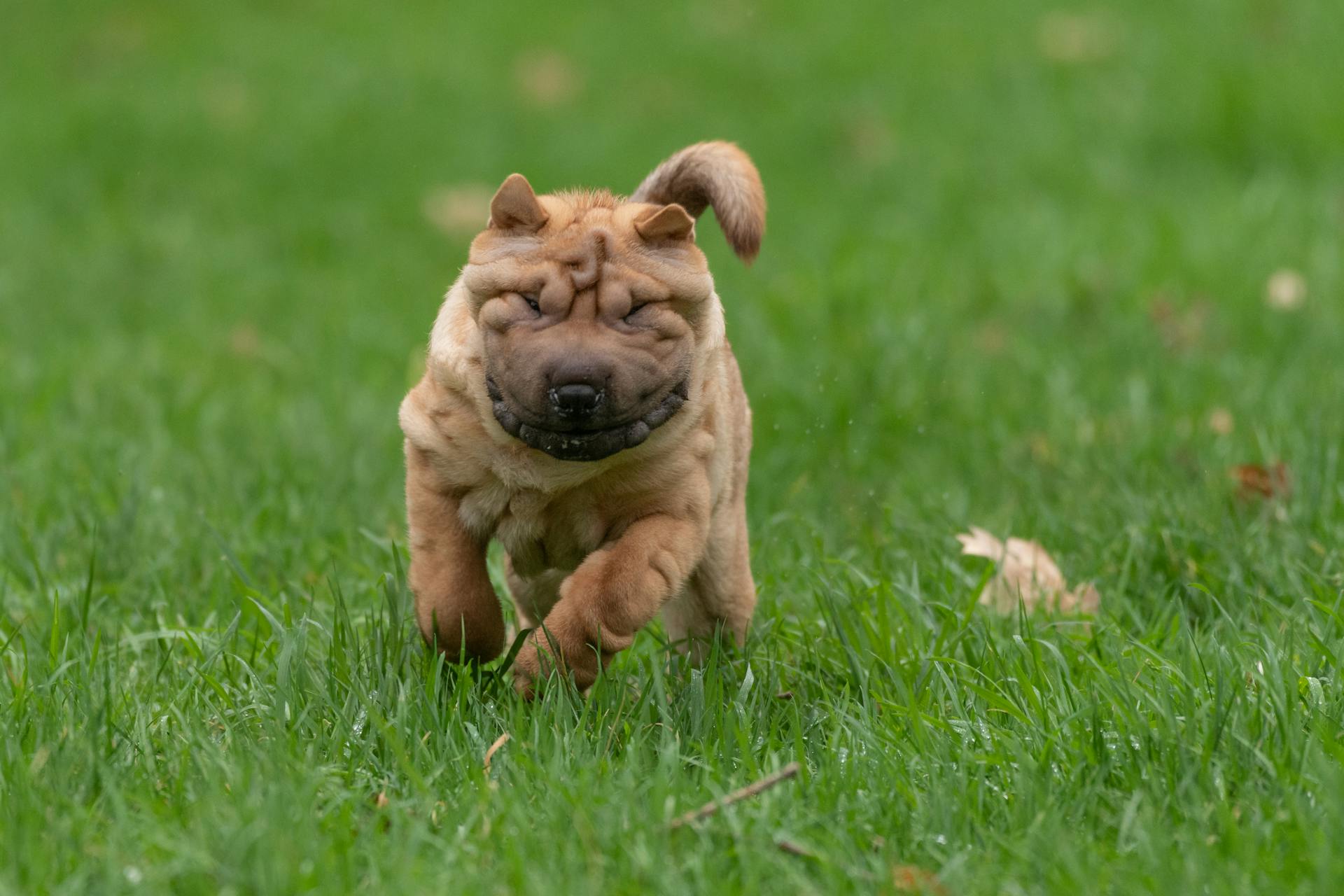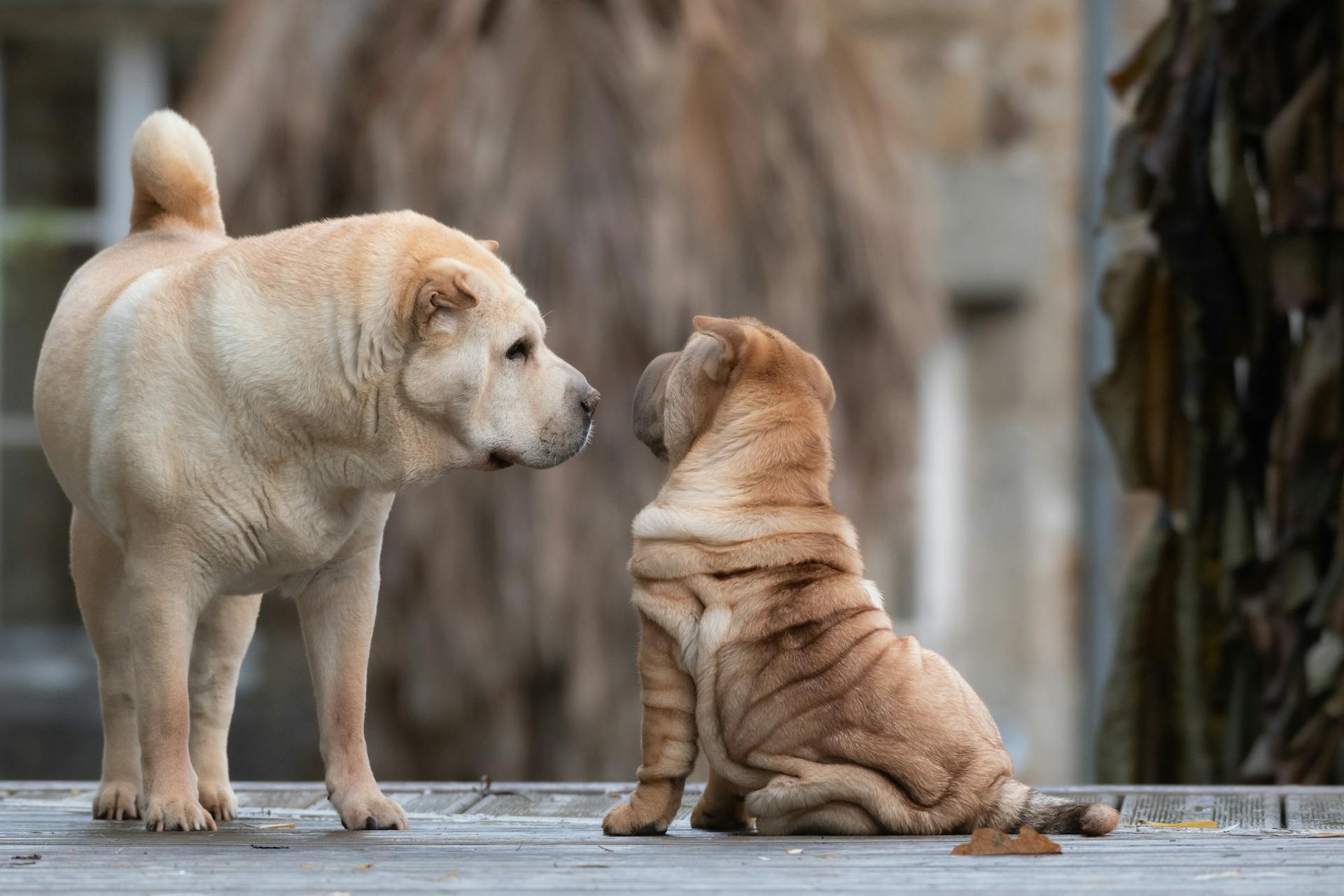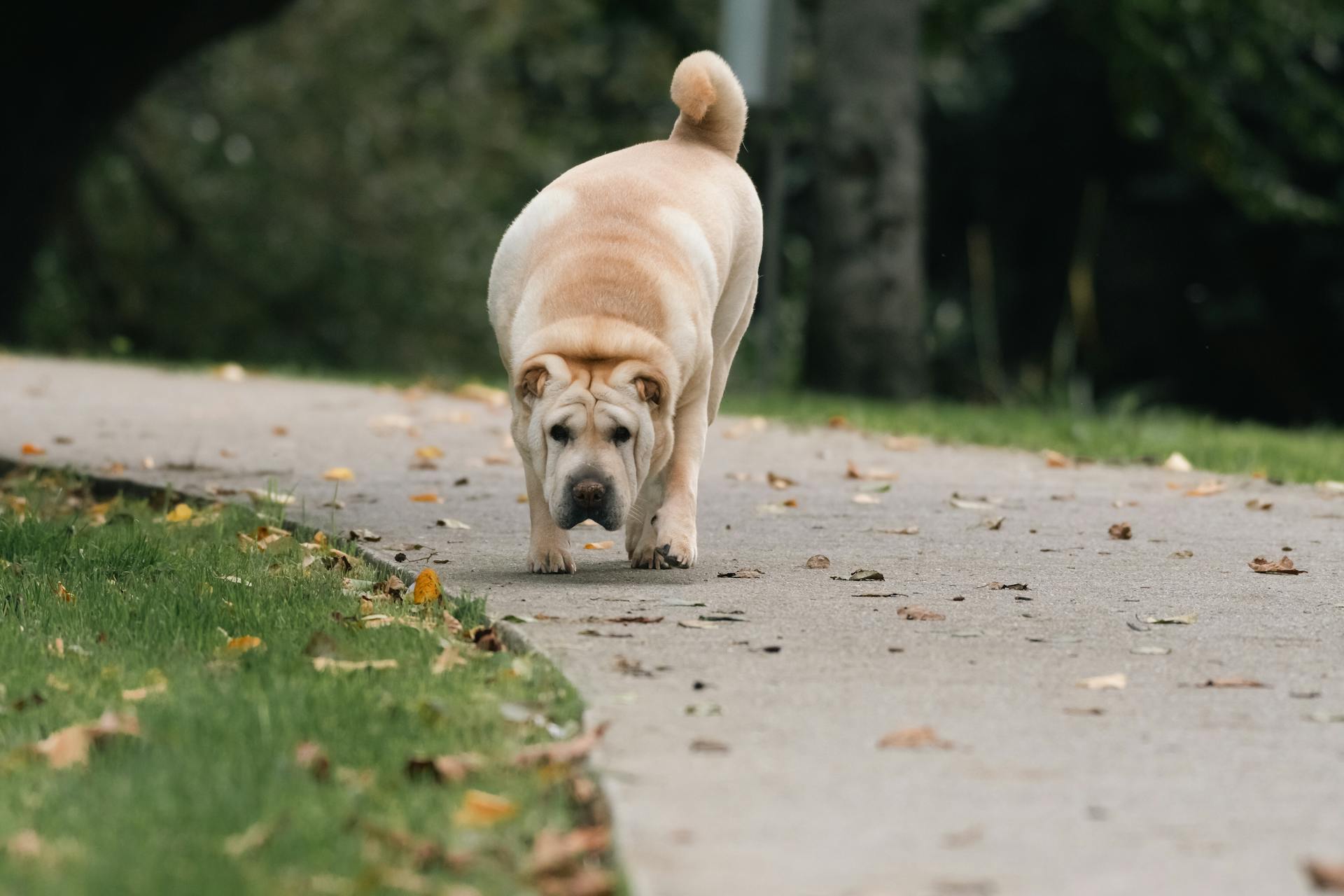
The Chinese Shar Pei is an ancient dog breed with a rich history dating back over 2,000 years. The breed originated in China, specifically in the southern province of Guangdong.
The Chinese Shar Pei was bred as a working dog, used for tasks such as guarding, hunting, and herding. They were highly valued for their loyalty and protective instincts.
One of the most distinctive features of the Chinese Shar Pei is its wrinkled skin, which is a result of their unique genetic makeup. The skin folds on a Chinese Shar Pei can be quite deep, requiring regular cleaning to prevent skin problems.
The breed was first recognized by kennel clubs in the 1970s, when they were introduced to the West. Since then, they have become a popular companion dog, prized for their affectionate nature and adaptability.
Explore further: Shar Pei Dog Skin Problems
The Ancient Origins
The Shar Pei is believed to have originated in the southern provinces of China, particularly around the area of Guangdong.
These early dogs were valued for their versatility, serving as hunters, farm animals' herders, and property guardians.
Their unique physical characteristics, such as their deep wrinkles and blue-black tongue, were highly valued for both practical reasons in work and as symbols of luck and protection.
The Shar Pei's loose, wrinkled skin was thought to protect it from the bites of animals and opponents, while its rough coat could deter bites and grabs.
Ancient Chinese statues and art pieces depict dogs resembling the Shar Pei, indicating their long-standing presence in Chinese culture.
The Shar Pei's history traces back over two thousand years to the Han Dynasty, where they were initially bred for various purposes, including hunting, herding, and guarding.
Here are some key facts about the Shar Pei's ancient origins:
- Originated in the southern provinces of China, particularly around Guangdong.
- Valued for their versatility in hunting, herding, and guarding.
- Unique physical characteristics, such as deep wrinkles and blue-black tongue, were highly valued.
- Depicted in ancient Chinese statues and art pieces.
- History dates back over two thousand years to the Han Dynasty.
History and Recognition
The Shar Pei's history is a fascinating one, marked by periods of popularity and decline. In ancient times, the breed was involved in various activities, from hunting and guarding to being a valued companion.
The breed's numbers and purity were at risk due to China's political and social upheavals, particularly in the mid-20th century. By the 1970s, the Shar Pei was considered one of the world's rarest dog breeds.
In 1973, a Hong Kong businessman named Matgo Law appealed to the international community to help save the breed, which led to great demand in the United States for examples of the breed. Unscrupulous breeders in Hong Kong, Macau, and Taiwan took advantage of this demand, crossing their remaining purebred animals with other breeds and selling the offspring to unwitting American buyers.
The resultant publicity led to the Shar Pei being named the world's rarest breed by The Guinness Book of Records in 1978, with only 60 remaining.
A fresh viewpoint: Chinese Dogs Breeds
When Recognized by AKC?
The Shar Pei's recognition by the American Kennel Club (AKC) was a significant milestone in its history, marking its transition from near-extinction to becoming a valued dog breed worldwide.
The AKC officially recognized the Shar Pei in 1992, a year that brought standardized breeding practices and increased popularity among dog enthusiasts in the United States and globally.
This recognition helped the Shar Pei breed gain more visibility and acceptance, paving the way for its growth as a beloved companion dog.
Who Saved the?
Who Saved the Shar Pei?
Matgo Law, a Hong Kong businessman and dog breeder, played a pivotal role in saving the Shar Pei from extinction. He appealed to dog lovers in the United States through a dog magazine in the early 1970s, highlighting the breed's critical situation and asking for help to preserve it.
By the 1970s, the Shar Pei was considered one of the world's rarest dog breeds, with only 60 remaining, and was named by The Guinness Book of Records as the world's rarest breed in 1978.
What Does Mean?
The name "Shar Pei" is a direct translation from Cantonese, literally meaning "sand skin". This unique name describes the breed's short, rough coat, which feels like sandpaper when stroked against the grain.
This distinctive coat was historically advantageous, providing the Shar Pei with an edge in escaping predators or adversaries during hunts or fights. The name "Shar Pei" is more than just a label, it's a nod to the breed's remarkable physical characteristics.
Broaden your view: Shar Pei Bear Coat Dog
Characteristics and Temperament
The Chinese Shar Pei is a breed that's as unique as it is loyal. They're known for their distinctive appearance, characterized by deep wrinkles that cover their head, body, and particularly around the face and neck.
Their broad, flat head and blue-black tongue are just a few of the features that set them apart. This unique appearance hints at a possible common ancestry with the Chow Chow.
Shar Peis have a short, bristly coat that comes in various colors, which is a result of their "sand skin" coat that provided a practical advantage in ancient times.
They're medium-sized dogs, known for their strength, square profile, and alert expression. This makes them excellent watchdogs.
Temperament-wise, Shar Peis are independent, loyal, and reserved with strangers. This can make them stubborn at times, requiring early socialization and consistent training.
Despite their reserved nature, Shar Peis are affectionate with their families and make great companions. Their loyalty and strength have made them a beloved breed for centuries.
Discover more: Bear Coat Chinese Shar Pei
Roles and Evolution
The Chinese Shar Pei's role in history has been shaped by its versatility and adaptability. Originally bred for multiple purposes, including hunting, herding, and guarding property.
Their excellent tracking abilities made them valuable hunters, particularly in tracking and hunting wild game in the dense forests of southern China. Their strong, muscular build and alert nature made them effective guard dogs, protecting homes and livestock.
The Shar Pei's fortunes waxed and waned with China's political and social upheavals, leading to periods where the breed's numbers and purity were at risk. By the 1970s, the Shar Pei was considered one of the world's rarest dog breeds.
Today, Shar Peis are primarily kept as companion animals, cherished for their unique appearance and calm, devoted temperament.
Evolution of the Role
The Shar Pei's role has undergone significant changes over the centuries, from its ancient origins as a versatile working dog in China to its modern-day status as a beloved companion animal.

In ancient times, the Shar Pei was bred for multiple purposes, including hunting, herding, and guarding property, showcasing its intelligence, independence, and alertness.
Their excellent tracking abilities made them valuable hunters, particularly in tracking and hunting wild game in the dense forests of southern China.
The Shar Pei's strong, muscular build and alert nature made them effective guard dogs, protecting homes and livestock.
However, by the mid-20th century, the Shar Pei's fortunes had declined due to China's political and social upheavals, leading to a period of severe decline.
This decline continued until the 1970s, when the Shar Pei was considered one of the world's rarest dog breeds, with only 60 remaining.
Today, the Shar Pei is primarily kept as a companion animal, cherished for its unique appearance and calm, devoted temperament.
Despite this shift from working dog to companion, the Shar Pei still retains its protective and loyal nature, making them excellent guard dogs.
The breed's popularity has led to some controversy, with some breeders selectively breeding Shar Peis for a smaller size, creating what they call the "miniature Shar Pei".
Discover more: Are Chow Chows Good Guard Dogs
Care and Upkeep

Shar Peis require a moderate walk or game session every day to stay healthy and prevent boredom.
It's essential to keep them from overheating, so be mindful of the weather and adjust their exercise accordingly.
A daily walk in a fenced area is recommended, as they may not be good at coming when called.
Their coat is generally easy to care for, requiring only weekly brushing, regardless of the type - rough, smooth, or rare bear type.
Deep folds and wrinkles must be inspected daily, cleaned, and dried regularly to avoid irritation or skin-fold pyoderma.
Shar Pei fever, a disorder that affects one in four Shar Peis, can cause kidney failure if left untreated, so monitor for fever and signs of swelling, especially on the ankle joints and muzzle.
Regular veterinary check-ups and a balanced diet can help prevent common health issues like Shar Pei Fever and hip dysplasia.
Their independent nature can be managed with socialization and training from a young age, but they may not be skilled in agility or obedience trials.
Frequently Asked Questions
Why are Shar-Peis so rare?
Shar-Peis were nearly extinct due to a lack of interest from the Chinese government, but thanks to one dedicated breeder, the breed was preserved. Their rarity is a fascinating story that highlights the power of individual efforts in saving a beloved breed.
Sources
- https://iheartdogs.com/the-history-and-origin-of-the-shar-pei-a-comprehensive-look/
- https://www.britannica.com/animal/Chinese-shar-pei
- https://bondivet.com/blogs/dog-breeds/shar-pei-dog-breed-characteristics-origin-and-care
- https://www.akc.org/dog-breeds/chinese-shar-pei/
- https://en.wikipedia.org/wiki/Shar_Pei
Featured Images: pexels.com


